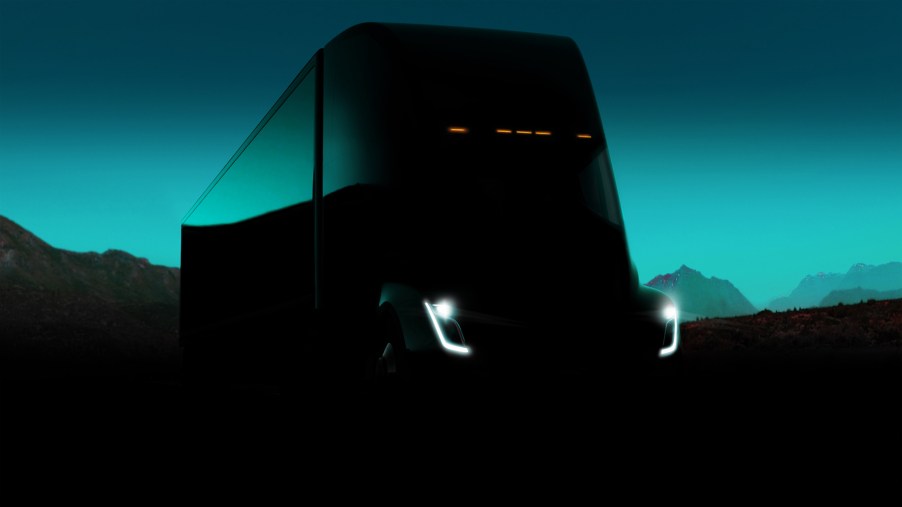
How Much Does a Tesla Semi Cost?
The Tesla Semi concept was born only a few years ago in 2017. The vehicle is a Class 8 all-electric-powered semi-tractor unit still in development. Although the EV maker planned to begin production this year, CNBC reported Tesla put that on hold until it can make its own lithium-ion battery cells. CEO Elon Musk said that once Tesla achieves high-volume lithium-ion battery production, it will also begin developing an all-electric cargo van.
Here’s everything else we know about the Tesla Semi thus far.
The Tesla Semi at a glance
Tesla originally announced its Semi would have a range of 500 miles on a full charge. The EV maker also claimed its new batteries could reach an 80 percent charge in about 30 minutes and run for an additional 400 miles. At the time, Tesla was using a bunch of Model 3 electric motors to power the prototype Tesla Semi. It would use the Tesla Megacharger, a solar-powered charging station.
As of this writing, Tesla has three Semi offerings: a rig with a 300-mile range and another with a 500-mile range. The third model is called the Founders Series and has no specs listed. However, it seems every model will pack four independent motors, boast instant traction control, and offer an enhanced Autopilot feature.
One of the most amazing aspects of the Tesla Semi is it can accelerate from 0 to 60 mph in just 20 seconds. Not only that, but it can also do so with 80,000 pounds hitched to it. We’re not sure how that benefits anyone, especially considering the possible load shift. Tesla’s website boasts of the Semi’s relatively low center of gravity for improved rollover protection. Engineers designed it with a center driving position, giving drivers maximum visibility and control.
The Tesla Semi also has a drag coefficient of 0.36. A lower coefficient means the vehicle is more efficient. A regular car’s average coefficient is around 0.30 to 0.40. The drag coefficient of the average semi-truck is between 0.50 and 0.90, depending on its design.
The first Semi unit’s base price is listed as $150,000, while the longer-range unit’s MSRP is $180,000. A base reservation costs $20,000 for both base models. The Founders Series is listed at $200,000, with a reservation cost of the same amount.
Tesla claims $200,000 in fuel savings
Tesla’s website claims a lower price of ownership amounting to $200,000 in fuel savings and a two-year payback period. However, the site doesn’t expound on the time frame of those savings, but we assume the savings are annual. If this is true, a Tesla Semi owner will get a return on their investment in terms of savings in a year. But when we glance at annual owner-operator cost reports, the math seems off.
According to FleetOwner, “The cost of running one big rig could be more than $185,000 per year … Two-thirds of the costs are vehicle-based, while the other third is driver-based.” This report was published in November 2014, with the latest data in 2019 from sites such as Schneider reporting annual operational costs ranging from $50,000 to $75,000. Either way, it seems Tesla needs to be clearer on what constitutes $200,000 in fuel savings.
Skepticism surrounds this EV
Among those who stay on top of auto news, it’s common knowledge that Tesla and its CEO are favorite targets of skeptics. This is nothing new. Throughout history, innovators willing to push the limits have often fallen under scrutiny. It’s merely something that comes with the territory of innovation. With that said, the skeptics have been fairly vocal about the Semi since Tesla unveiled it in November 2017.
In an interview with Business Insider, Martin Daum, the head of Daimler’s truck division, said of the Semi: “If Tesla really delivers on this promise, we’ll obviously buy two trucks: one to take apart and one to test, because if that happens, something has passed us by … But for now, the same laws of physics apply in Germany and in California.”
Maybe someone is taking the “Tesla vs. Daimler” reports a bit personally.
Markus Lienkamp, the chair of automotive engineering at the Technical University of Munich, told Business Insider: “The battery for a Tesla Semi must have a capacity of about 1,000 kWh per 100 kilometers, about 130 kWh … This is technically not easily feasible, and it’s also pointless both economically and ecologically.”
By “pointless,” Lienkamp means the supposed increased demands placed on power grids during recharging. But Lienkamp seems to be missing one crucial piece of information: Tesla’s Megacharger network will supposedly comprise “off-grid” Megacharger stations. In other words, Tesla plans to power its Megacharger stations using renewable power sources such as solar and possibly wind. Maybe some haters read the headlines, blew a gasket, and automatically began Tesla-hating before getting all the details.
This might explain why Musk has decided to put Tesla Semi production on hold until his company can produce its own batteries. Not only is Musk a big online troll, but he also likes to feign ignorance when he knows exactly what he’s doing. It’ll be interesting how this all plays out, so stay tuned!


